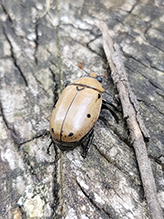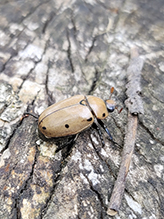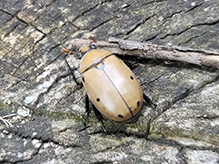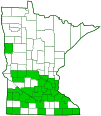grapevine beetle
(Pelidnota punctata)
Conservation • Description • Habitat • Ecology • Distribution • Taxonomy
|
|
||||||||||||||
Description |
Grapevine beetle is a common and widespread, large, showy, shining leaf chafer beetle. It occurs in the United States and southern Canada east of the Great Plains. In Minnesota it is relatively common in the southern half of the state, mostly absent from the northern half. Adults are found from June to August in and near deciduous forests and thickets, in vineyards, and in gardens. They eat the leaves and fruit of both wild and cultivated grapevines, but they do not occur in numbers large enough to be considered a pest. The larvae dwell in the soil and feed on the rotting wood of many species of deciduous trees. Adults are 11⁄16″ to 1 1⁄16″ (18 to 27 mm) in length, shiny, and brownish-yellow, yellowish-orange, or yellowish-brown. The body is stout, elongated oval when viewed from above, and convex when viewed from the side. The jaws (mandibles) are black. The antennae are orange and have 9 or 10 segments. The last 3 or 4 segments are expanded sideways on one side into long flattened lobes. The antennal lobes can be closed into a tight club or fanned out to detect odors. The plate covering the thorax (pronotum) has a bead along the front margin that is complete, uninterrupted. The sides are narrowly but distinctly flattened (margined). There is a single black spot on each side near the lateral margin. The plate between the wing bases (scutellum) is small and nearly triangular. The hardened wing covers (elytra) are finely and shallowly but distinctly pitted (punctate). This is the feature that gives the beetle its species epithet. The sides are narrowly margined. There are three black spots near the lateral margin of each elytron, one in front in the shoulder (humeral) area, one in the middle, and one near the tip. The black markings on the pronotum and elytra is the feature that gives the genus its name: pelidnos is Greek for “black” and nota is Latin for “markings”. The underside of the abdomen ranges from yellowish-brown to black. The legs are strong, spiny, and optimized for digging. On the front legs, the fourth segment (tibia) is widened and toothed on the outside. The last part of each leg (tarsus), corresponding to the foot, has five segments. The coloration of this species is variable, both geographically and between populations, resulting in ten subspecies having been described. All of those subspecies are now considered synonyms of a single polymorphic species. In some populations the scutellum is black, in others it is the same color as the elytra. In some populations the spots on the pronotum and elytra are larger and distinct, in some they are smaller, and in some they are indistinct or even absent. In northern populations the legs are dark, the same color as the underside. In southern populations, they are light, the same color as the elytra. |
Size |
Total length: 11⁄16″ to 1 1⁄16″ (18 to 27 mm) |
Similar Species |
Habitat |
Deciduous forests, thickets, vineyards, and gardens |
Ecology |
Season |
June to August |
Behavior |
Adults are active at night and will come to lights. They are found clinging to vegetation during the day. They fly fast, usually with a curving flight pattern. |
Life Cycle |
In Minnesota larvae take two years to become adults. In the south they may develop faster. |
Larva Food |
Rotting wood of deciduous trees |
Adult Food |
Leaves and fruit of grapevines |
Distribution |
||
|
Sources |
|
| 7/27/2024 | ||
Occurrence |
||
Common |
||
Taxonomy |
|
Order |
Coleoptera (Beetles) |
Suborder |
Polyphaga (Water, Rove, Scarab, Long-horned, Leaf, and Snout Beetles) |
Infraorder |
Scarabaeiformia |
Superfamily |
Scarabaeoidea (Scarabs, Stag Beetles, and Allies) |
Family |
Scarabaeidae (scarabs) |
Subfamily |
Rutelinae (shining leaf chafers) |
Tribe |
Rutelini |
| Subtribe | Pelidnotina |
Genus |
Pelidnota (precious metal scarabs) |
Subordinate Taxa |
|
|
|
Synonyms |
|
Melolontha lutea Pelidnota brevicollis Pelidnota brevis Pelidnota debiliceps Pelidnota francoisgenieri Pelidnota genieri Pelidnota hudsonica Pelidnota lutea brevicollis Pelidnota lutea hudsonica Pelidnota lutea pallidipes Pelidnota oblonga Pelidnota oblonga debiliceps Pelidnota oblonga ssp. ponderella Pelidnota pallidipes Pelidnota ponderella Pelidnota punctata brevis Pelidnota punctata strenua Pelidnota strenua Pelidnota tarsalis Scarabaeus punctatus |
|
Common Names |
|
grapevine beetle spotted june beetle spotted pelidnota |
|
Glossary
Elytra
The hardened or leathery forewings of beetles used to protect the fragile hindwings, which are used for flying. Singular: elytron.
Pronotum
The exoskeletal plate on the upper side of the first segment of the thorax of an insect.
Punctate
Dotted with pits (punctures), translucent sunken glands, or colored spots of pigment.
Scutellum
The exoskeletal plate covering the rearward (posterior) part of the middle segment of the thorax in some insects. In Coleoptera, Hemiptera, and Homoptera, the dorsal, often triangular plate behind the pronotum and between the bases of the front wings. In Diptera, the exoskeletal plate between the abdomen and the thorax.
Tarsus
On insects, the last two to five subdivisions of the leg, attached to the tibia; the foot. On spiders, the last segment of the leg. Plural: tarsi.
Tibia
The fourth segment of an insect leg, after the femur and before the tarsus (foot). The fifth segment of a spider leg or palp. Plural: tibiae.
Visitor Photos |
||
Share your photo of this insect. |
||
This button not working for you? |
||
Kari Miller |
||
 |
 |
|
 |
||
MinnesotaSeasons.com Photos |
||
|
||
|
||

Slideshows |
|

Visitor Videos |
||
Share your video of this insect. |
||
This button not working for you? |
||
|
Other Videos |
||
Grapevine Beetle Pelidnota punctata Feeding on a Leaf. |
About
Sep 20, 2015 August 4th 2015, in Victoriaville, Québec, Canada. |
Grapevine beetle (Pelidenota punctata) |
About
Jul 18, 2010 This beetle is a loud flyer |
Pelidnota punctata On Wild Grapes |
About
Jan 27, 2022 These large, beautiful orange beetles with dark spots feed on wild and cultivated grape leaves. This native species can be found usually in low numbers on the native Wild Grape (Vitis riparia) in southern Ontario. |
Grapevine Beetle Breaks My Heart |
About
Jun 29, 2021 Yes, sadness. Couldn't wait to share this Grapevine Beetle with you! Filming wildlife is not always a walk in the park. Well, it usually is, but what I mean is it often ends in failure. Grapevine beetles are large beetles or Coleoptera. Impressive insects with iridescent green legs, mahogany colored elytra (back) and club shaped antenna. I am sure you will either laugh or shake your head in disappointment. Grapevine beetles are not easy to work with, lol |

Visitor Sightings |
||
Report a sighting of this insect. |
||
This button not working for you? |
||
Danielle |
Location: St. Paul, north side found on stump of rotting tree |
| Kari Miller 7/2/2023 |
Location: Mower County |
 |
MinnesotaSeasons.com Sightings |
||
|

Created: 7/8/2023 Last Updated: © MinnesotaSeasons.com. All rights reserved. |
